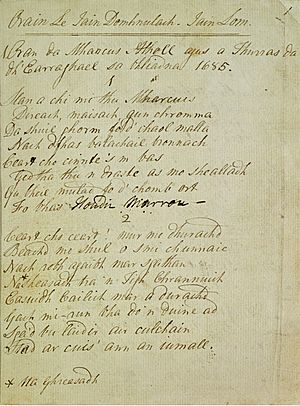Sìleas na Ceapaich facts for kids
Sìleas na Ceapaich (also known as Cicely Macdonald of Keppoch) was a famous Scottish poet. She lived a long time ago, from about 1660 to 1729. She wrote many poems in the Scottish Gaelic language. Her Gaelic name, Sìleas, can also be called Cicely or Julia in English.
Her Life Story
Sìleas grew up in a family that owned land in the Scottish Highlands. This was a time when the clan system was still very important. Her father, Archibald Macdonald, was the 15th Chief of Clan MacDonald of Keppoch. Her mother was Mary Macmartin. Sìleas's brother, Coll, later became the 16th Chief. Even though her family had lost some of their old power, they were still seen as important in Gaelic society.
Sìleas married Alexander Gordon of Camdell. He worked for the Duke of Gordon. She spent most of her adult life living at Beldorney Castle in Banffshire. However, she grew up in Lochaber. We know that Sìleas had at least eight children. She had five sons and three daughters.
Her Amazing Poems
Sìleas is most famous for the 23 poems she wrote. All of these poems were written in the Scottish Gaelic language. Many of her poems were about politics. They often showed strong support for the Jacobite cause. This meant she supported the return of the Stuart royal family to the throne.
Other poems she wrote included sad songs, called laments. These were for friends who died in the uprisings of that time. She also wrote funny advice for women who were not yet married. A few of her poems were about her religious beliefs.
Among her Jacobite poems is one called Tha mi am chadal, which means "I am sleeping." This poem is very similar to an old Irish song. Her most well-known poem was written around 1723. It is a lament for Alasdair Dubh, who was the 11th Chief of Clan MacDonald of Glengarry. This poem connects back to very old stories and myths. Like her other works, this lament was mostly for people within the different branches of Clan Donald.
Her poems that still exist use a mix of old Gaelic poetry styles and newer ones. It is clear that her poems were meant to be sung. Some of them were even based on popular folk song tunes of her time.


